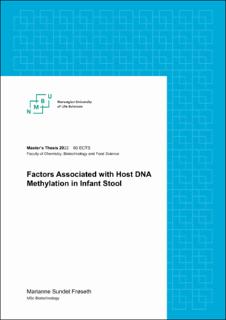| dc.contributor.advisor | Rudi, Knut | |
| dc.contributor.advisor | Nilsen, Morten | |
| dc.contributor.author | Frøseth, Marianne Sundet | |
| dc.date.accessioned | 2022-10-28T08:58:15Z | |
| dc.date.available | 2022-10-28T08:58:15Z | |
| dc.date.issued | 2022 | |
| dc.identifier.uri | https://hdl.handle.net/11250/3028791 | |
| dc.description.abstract | DNA methylation plays an important role in the regulation of gene expression. There are several factors that can affect DNA methylation, with a complex interplay between the different mechanisms. The maturation of the infant gut microbiota could potentially be one of these factors. During the first year of life, there is shown to be a significant increase in the short chain fatty acid (SCFA) butyrate and a change in bacterial composition. How these changes potentially modulate the DNA methylation pattern is not well established. Therefore, the main aim of this thesis is to study if age, gut bacterial composition, and butyrate are associated with the DNA methylation levels of selected immune-related genes from feces.
Infant fecal samples from the study Preventing atopic dermatitis and allergies (PreventADALL) were used. As a significant increase in butyrate has been observed between 6- and 12-months of age, samples from these two time points were studied. To reveal the DNA methylation level of the selected genes, extracted DNA was bisulfite converted prior to Illumina sequencing. The taxonomic- and short chain fatty acid composition in feces were determined with 16S rRNA gene sequencing and gas chromatography, respectively. The results showed a significant increase in the DNA methylation level of defensin alpha 5 and toll-like receptor 4 with age. In contradiction, interleukin-4 showed a significant decrease in DNA methylation level with age. No significant correlations were found between butyrate and the mean DNA methylation levels, but potential trends were observed between DNA methylation and the bacterial composition.
In conclusion, the results indicate that age is a potential modulator of DNA methylation. The lack of correlations to butyrate indicates that the significant differences between the age groups are not caused by the increase in butyrate. However, trends between the DNA methylation pattern and bacteria suggest that the bacterial composition could be a potential modulator. | en_US |
| dc.description.abstract | DNA-metylering spiller en viktig rolle for regulering av genuttrykket. Det er flere faktorer som kan påvirke DNA-metylering, og det er et komplekst samspill mellom de ulike mekanismene. Modningen av tarmmikrobiotaen hos spedbarn kan potensielt være en av disse faktorene. I løpet av det første leveåret er det vist å være en signifikant økning av den kortkjeda fettsyren butyrat og en endring i den bakterielle sammensetningen. Hvordan disse endringene potensielt modulerer DNA-metyleringsmønsteret er ikke godt etablert. Hovedmålet med denne oppgaven er derfor å studere om alder, bakteriesammensetning i tarmen og butyrat er assosiert med DNA-metyleringsnivåene av utvalgte immun-relaterte gener fra avføring.
Avføringsprøver fra spedbarn ble hentet fra studien “Preventing atopic dermatitis and allergies (PreventADALL). På grunn av den tidligere observerte økningen av butyrat mellom 6- og 12-måneders alder ble prøver fra disse to tidspunktene studert. For å bestemme DNA-metyleringsnivåene i utvalgte gener ble ekstrahert DNA bisulfitt-konvertert før Illumina-sekvensering. Den taksonomiske sammensetningen og sammensetning av kortkjeda fettsyrer i avføringen ble bestemt med henholdsvis 16S rRNA gensekvensering og gasskromatografi. Resultatene viste en signifikant økning i DNA-metylerings-nivåene av defensin alfa 5 og toll-liknende reseptor 4 med alder. Interleukin-4 viste derimot en signifikant reduksjon i DNA-metyleringsnivå med alder. Ingen signifikante korrelasjoner ble funnet mellom butyrat og de gjennomsnittlige DNA-metyleringsnivåene, men potensielle trender mellom DNA-metylering og den bakterielle sammensetningen ble observert.
For å konkludere viser resultatene at alder er en potensiell modulator av DNA metylering. Mangelen på korrelasjoner til butyrat indikerer at de signifikante forskjellene mellom aldersgruppene ikke skyldes økningen av butyrat. Trendene som ble observert mellom DNA-metyleringsmønsteret og de observerte bakteriene indikerte derimot at den bakterielle sammensetningen kan være en potensiell modulator. | en_US |
| dc.language.iso | eng | en_US |
| dc.publisher | Norwegian University of Life Sciences, Ås | en_US |
| dc.rights | Attribution-NonCommercial-NoDerivatives 4.0 Internasjonal | * |
| dc.rights.uri | http://creativecommons.org/licenses/by-nc-nd/4.0/deed.no | * |
| dc.title | Factors associated with host DNA methylation in infant stool | en_US |
| dc.type | Master thesis | en_US |
| dc.description.localcode | M-BIOTEK | en_US |

